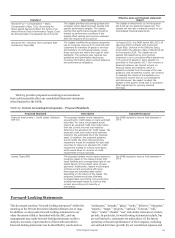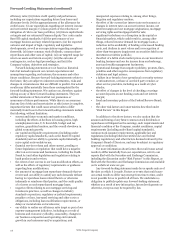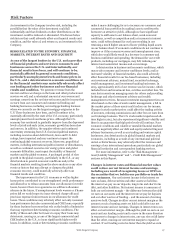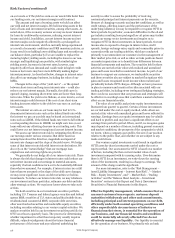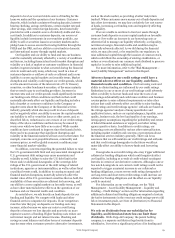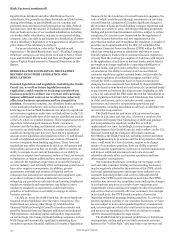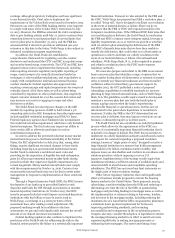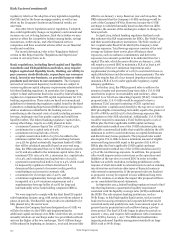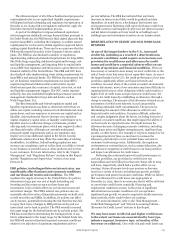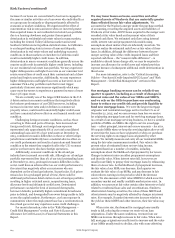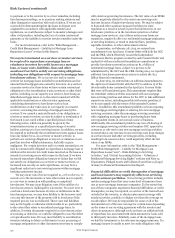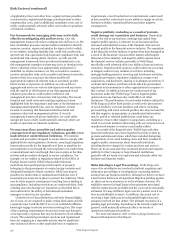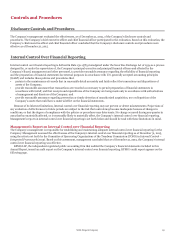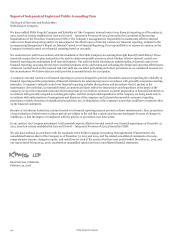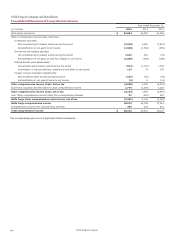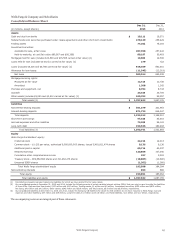Wells Fargo 2015 Annual Report Download - page 127
Download and view the complete annual report
Please find page 127 of the 2015 Wells Fargo annual report below. You can navigate through the pages in the report by either clicking on the pages listed below, or by using the keyword search tool below to find specific information within the annual report.revenue effect. Even though they can act as a “natural hedge,”
the hedge is not perfect, either in amount or timing. For
example, the negative effect on revenue from a decrease in the
fair value of residential MSRs is generally immediate, but any
offsetting revenue benefit from more originations and the MSRs
relating to the new loans would generally accrue over time. It is
also possible that, because of economic conditions and/or a weak
or deteriorating housing market, even if interest rates were to
fall or remain low, mortgage originations may also fall or any
increase in mortgage originations may not be enough to offset
the decrease in the MSRs value caused by the lower rates.
We typically use derivatives and other instruments to hedge
our mortgage banking interest rate risk. We may not hedge all of
our risk, and we may not be successful in hedging any of the risk.
Hedging is a complex process, requiring sophisticated models
and constant monitoring, and is not a perfect science. We may
use hedging instruments tied to U.S. Treasury rates, LIBOR or
Eurodollars that may not perfectly correlate with the value or
income being hedged. We could incur significant losses from our
hedging activities. There may be periods where we elect not to
use derivatives and other instruments to hedge mortgage
banking interest rate risk.
We rely on GSEs to purchase mortgage loans that meet their
conforming loan requirements and on the Federal Housing
Authority (FHA) to insure loans that meet their policy
requirements. These loans are then securitized into either GSE
or GNMA securities that are sold to investors. In order to meet
customer needs, we also originate loans that do not conform to
either GSE or FHA standards, which are referred to as
“nonconforming” loans. We generally retain these
nonconforming loans on our balance sheet. When we retain a
loan on our balance sheet not only do we forgo fee revenue and
keep the credit risk of the loan but we also do not receive any
sale proceeds that could be used to generate new loans. If we
were unable or unwilling to continue retaining nonconforming
loans on our balance sheet, whether due to regulatory, business
or other reasons, our ability to originate new mortgage loans
may be reduced, thereby reducing the fees we earn from
originating and servicing loans. Similarly, if the GSEs or the FHA
were to limit or reduce their purchases or insuring of loans, our
ability to fund, and thus originate new mortgage loans, could
also be reduced. We cannot assure that the GSEs or the FHA will
not materially limit their purchases or insuring of conforming
loans or change their criteria for what constitutes a conforming
loan (e.g., maximum loan amount or borrower eligibility). Each
of the GSEs is currently in conservatorship, with its primary
regulator, the Federal Housing Finance Agency acting as
conservator. We cannot predict if, when or how the
conservatorship will end, or any associated changes to the GSEs
business structure and operations that could result. As noted
above, there are various proposals to reform the housing finance
market in the U.S., including the role of the GSEs in the housing
finance market. The impact of any such regulatory reform
regarding the housing finance market and the GSEs, including
whether the GSEs will continue to exist in their current form, as
well as any effect on the Company’s business and financial
results, are uncertain.
For more information, refer to the “Risk Management –
Asset/Liability Management – Mortgage Banking Interest Rate
and Market Risk” and “Critical Accounting Policies” sections in
this Report.
We may be required to repurchase mortgage loans or
reimburse investors and others as a result of breaches
in contractual representations and warranties, and we
may incur other losses as a result of real or alleged
violations of statutes or regulations applicable to the
origination of our residential mortgage loans. The
origination of residential mortgage loans is governed by a variety
of federal and state laws and regulations, including the Truth in
Lending Act of 1968 and various anti-fraud and consumer
protection statutes, which are complex and frequently changing.
We often sell residential mortgage loans that we originate to
various parties, including GSEs, SPEs that issue private label
MBS, and other financial institutions that purchase mortgage
loans for investment or private label securitization. We may also
pool FHA-insured and VA-guaranteed mortgage loans which
back securities guaranteed by GNMA. The agreements under
which we sell mortgage loans and the insurance or guaranty
agreements with the FHA and VA contain various
representations and warranties regarding the origination and
characteristics of the mortgage loans, including ownership of the
loan, compliance with loan criteria set forth in the applicable
agreement, validity of the lien securing the loan, absence of
delinquent taxes or liens against the property securing the loan,
and compliance with applicable origination laws. We may be
required to repurchase mortgage loans, indemnify the
securitization trust, investor or insurer, or reimburse the
securitization trust, investor or insurer for credit losses incurred
on loans in the event of a breach of contractual representations
or warranties that is not remedied within a period (usually
90 days or less) after we receive notice of the breach. Contracts
for mortgage loan sales to the GSEs include various types of
specific remedies and penalties that could be applied to
inadequate responses to repurchase requests. Similarly, the
agreements under which we sell mortgage loans require us to
deliver various documents to the securitization trust or investor,
and we may be obligated to repurchase any mortgage loan as to
which the required documents are not delivered or are defective.
We may negotiate global settlements in order to resolve a
pipeline of demands in lieu of repurchasing the loans. We
establish a mortgage repurchase liability related to the various
representations and warranties that reflect management’s
estimate of losses for loans which we have a repurchase
obligation. Our mortgage repurchase liability represents
management’s best estimate of the probable loss that we may
expect to incur for the representations and warranties in the
contractual provisions of our sales of mortgage loans. Because
the level of mortgage loan repurchase losses depends upon
economic factors, investor demand strategies and other external
conditions that may change over the life of the underlying loans,
the level of the liability for mortgage loan repurchase losses is
difficult to estimate and requires considerable management
judgment. As a result of the uncertainty in the various estimates
underlying the mortgage repurchase liability, there is a range of
losses in excess of the recorded mortgage repurchase liability
that are reasonably possible. The estimate of the range of
possible loss for representations and warranties does not
represent a probable loss, and is based on currently available
information, significant judgment, and a number of assumptions
that are subject to change. If economic conditions or the housing
market worsen or future investor repurchase demand and our
success at appealing repurchase requests differ from past
experience, we could have increased repurchase obligations and
increased loss severity on repurchases, requiring significant
additions to the repurchase liability.
Additionally, for residential mortgage loans that we
originate, borrowers may allege that the origination of the loans
did not comply with applicable laws or regulations in one or
more respects and assert such violation as an affirmative defense
Wells Fargo & Company
125


